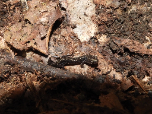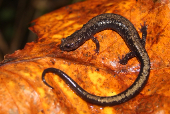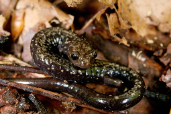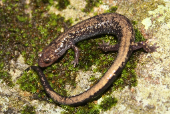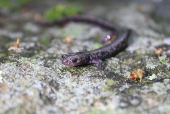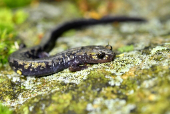Peaks of Otter Salamander (Plethodon hubrichti)
Description: The adult Peaks of Otter salamander is characterized by a dark-brown dorsum with heavy brassy flecking down its entire length. The dorsum and sides of P. hubrichti may also be lightly speckled with white, while the venter is not spotted and ranges from light to charcoal grey in color. Males have small mental glands immediately behind the chin. While the Peaks of Otter salamander is superficially similar to the Cheat Mountain salamander (P. nettingi), the two species are differentiated by a higher concentration of metallic flecking on the dorsum of P. hubrichti, and the presence of a usual 19 costal grooves compared to the variable 17–19 costal grooves of P. nettingi. Although Petranka stated that hatchlings have a distinct dorsal stripe consisting of reddish spots, this was never seen in over 100 neonates observed, which have a uniform dark-grey dorsum. Brassy flecks begin to appear when salamanders reach about 25 mm snout-to-vent length.
Habitat: P. hubrichti occupies forest floor habitats and is generally found at elevations above 845 meters
Range: The Peaks of Otter salamander is endemic to a 19-km stretch along the Blue Ridge Parkway in the Peaks of Otter area of the Blue Ridge Mountains in Bedford, Botetourt, and Rockbridge Counties of west-central Virginia.
Found in these States:
VA
Diet: They forage on a variety of invertebrates, and are occasionally found climbing trees.
Reproduction: The first observations of a P. hubrichti nest were made in spring and summer of 2005, at a study site near Onion Mountain in Bedford County A cluster of about 10, 5.5 mm diameter eggs, attended by the brooding female, was found beneath a rock embedded in the soil, hanging from the soil chamber ceiling. After 42 to 48 days of development, motile embryos with visible eyes were observed in the eggs, and 16 days later, hatchlings were found at the nest site.
The number of eggs per female ranged from 1 to 12 with a mean of 8.5 (95% CI 8.2 to 8.9). The number of eggs per female P. hubrichti increased directly with mass and elevation to a maximum of 12 eggs per female at 1000 m and then decreased slightly above 1000 m. While females found at higher elevations, near optimal elevations, typically produced more eggs per individual there was a greater percentage of females gravid at lower elevations. Combining data on salamander densities, number of eggs per female, and % gravid females (percentage of females in a population that are carrying eggs) allowed for the calculation of reproductive output for populations of salamanders at various elevations. While females at lower elevations reproduced more frequently than females nearer optimal elevations, the pattern for reproductive output was similar to that seen in eggs per female with reproductive output increasing from low elevations to a maximum near 900 m and then declining beyond that elevation.
Status: Listed as Vulnerable under Criterion D2 because it is only known from one threat-defined location and it is expected to be prone to the effects of climate change, which could drive the species to Critically Endangered or Extinct in a very short time in an uncertain future.
»» Kingdom: Animalia - Animals
»» Phylum: Chordata - Chordates
»» Subphylum: Vertebrata - Vertebrates
»» Class: Amphibia - (Amphibians)
»» Order: Caudata - Salamanders
»» Family: Plethodontidae - Lungless Salamanders
»» Genus: Plethodon
»» Species: Plethodon hubrichti - Peaks of Otter Salamander
This article uses material from the Wikipedia article "Peaks of Otter Salamander", which is released under the Creative Commons Attribution-Share-Alike License 3.0. Content may have been omitted from the original, but no content has been changed or extended.
|



